跑马拉松十年,我收获了什么?
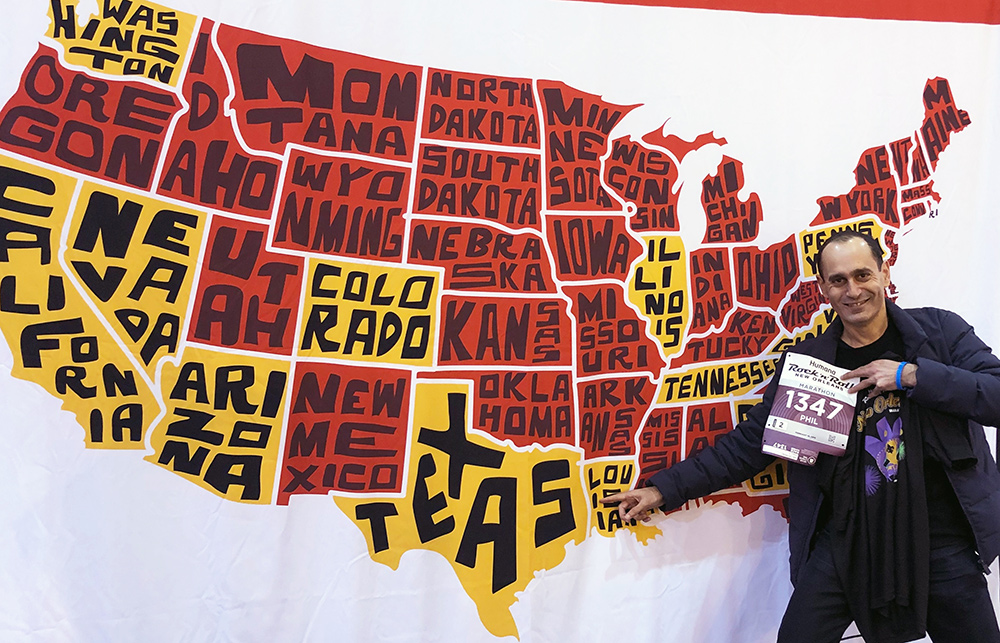
这个标题提出的问题非常具有阿拉斯加特色。今年6月,在安克雷奇市长马拉松比赛进行到一半时,我正在一条绿树成荫的碎石小道上跑着,另一位跑者指给我看,我那时并不害怕。我抓紧时间跑步,我只想安全地完成比赛,最终实现跑完美国各州(以及额外增加的华盛顿特区)全马公路赛的目标。
多年来,我在参加马拉松比赛时遭遇了各种挑战和不幸:由于训练不足,我经常会感到不适;在离终点线不远处呕吐,我在罗德岛州和弗吉尼亚参加比赛时就出现了这种情况(每次比赛用时不到四个小时,但就在最后不到一分钟功亏一篑!),因为我的碳水化合物补充策略不当;由于虚脱被抬入医疗帐篷(两次!分别在威斯康星州和爱荷华州);乳头擦伤(只需一次就会得到教训)等等。但要是遇到熊?那就太糟了。
在阿拉斯加比赛中,我很幸运。我刚刚从那只熊和她的两个幼崽休息的地方跑过。熊的出现迫使比赛总监不得不临时为我身后的数百名选手重新安排了比赛路线,但我仍沿着原定路线跑。
比赛顺利结束。(当我发现只有我一人出现在树木茂密的赛段时,我唱起了“Fozzie Bear stay away, Fozzie Bear stay away”,我感觉不那么害怕了。)最终,我越过了设在市中心安克雷奇公园的第51条终点线。共有389名选手完成了此次马拉松比赛,我是其中之一,还包括当日和我一起加入50州完赛俱乐部的少数人。
比赛期间,倾盆大雨,人群稀少,所以没有多少欢呼声。尽管这是我长达十年追求到达的巅峰,但那一刻对我来说有点平淡,这也说明这并不是什么大不了的事。我至少赢得了奖牌发放者的喝彩。我向她喊道,“我刚刚完成了我的50个州马拉松比赛目标!”她听到后,热情地与我击掌祝贺,但仍与我保持社交距离,我们只有指尖碰在一起。
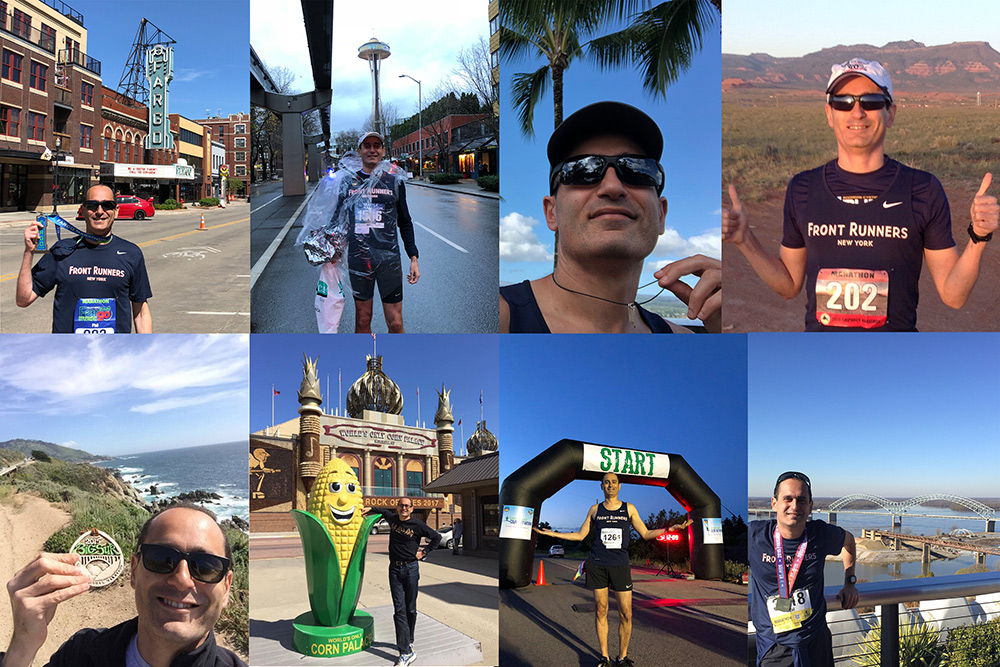
就这样,多年来主宰我生活的挑战最终完结,在参加马拉松比赛期间,我游览过很多美丽壮观的地方,如北卡罗来纳州阿什维尔的比尔特莫尔庄园、加利福尼亚州大苏尔的悬崖,以及位于阿拉巴马州亨茨维尔的美国太空火箭中心等。
在实现这个目标时,我加入了一个马拉松运动员小团体:50州马拉松俱乐部(50 States Marathon Club)。是的,我们有一个俱乐部——由一群业余跑者志愿组成的团体,为完赛者提供认证,并决定在哪个州举办马拉松比赛。俱乐部要求提供完成的每场比赛的证明,已为1,821人认证。(还有很多人也完成了比赛,但尚未经俱乐部官方认可。)最终会有更多的铁杆马拉松运动员加入这一队伍:俱乐部拥有近 5,000 名会员,并且仍在不断发展壮大。
目前,马拉松比赛的整体情况并非如此。根据贸易组织Running USA的数据,2019年,美国马拉松参赛人次从2014年的峰值55.1万降到42.7万。(由于2020年大多数比赛被取消,因此无2020年数据)。可供选择的比赛也越来越少——现在仍有约 1,000 场美国马拉松比赛,低于 2015 年1,200 场的历史最高水平。几十年风靡之后,马拉松渐渐失去了一些人气,因为跑者喜欢半程马拉松等短距离比赛以及铁人三项、最强泥人(Tough Mudder)和主车团(Peloton)等替代项目。
50州马拉松俱乐部的会员包括大量退伍军人和航空公司工作人员,他们可以享受机票和酒店折扣价格,旅行更加实惠。俱乐部往往会吸引多产马拉松运动员,而不是超快马拉松运动员。(跑完全程马拉松需要三小时以下的人一般不会参加那么多比赛。)
尽管追逐目标很有趣,但我很快发现,跑步和生活一样,无论你取得的成就多么令人印象深刻,总会有人超越你。一名50州俱乐部会员已经七次完成了这项壮举。还有一组跑者也跑完了50州马拉松,且每场马拉松用时均不到四个小时。(我必须重新参加18场马拉松才能获得资格。)此外,还有一个高级俱乐部,会员全部是至少完成300场马拉松的跑者。
“这是一种承诺,一种爱,有时简直会让人觉得精神失常,”俱乐部主席洛伊斯•伯科维茨说,她已经五次跑完50州马拉松,最近一次比赛是2019年底在华盛顿贝灵厄姆。“我想说,我们很多会员都有些不正常,”这位前人力资源专家开玩笑说。
我完全同意。当人们问我这些年来我为什么坚持跑马拉松时,我会开玩笑地说:“因为这50个州就在那。”但说真的,我这样做有多种原因。首先,我只是喜欢马拉松的长距离,我共参加了71场马拉松比赛。其次,我喜欢旅行。但还有一些其他因素:我是一名相当不错的跑者,只是不是一名出色的跑者。在这71场比赛中,没有一场比赛的速度足以让我获得参加波士顿马拉松比赛(美国最负盛名的比赛)的资格。我重量不重质。尽管如此,随着我参加的马拉松越来越多,并在2017年终于战胜了困扰我的伤病,我终于意识到,只要训练更加严格、更加科学,我可以跑得更快,比赛对我这个中年人的身体带来的伤害也会越小,这个发现本身就是一大回报,是我要追求的更高成就中的另一个目标。
纯属偶然
和人类的每一项活动一样,长跑也有自己的文化和亚文化。一些跑者把参加马拉松视为一项遗愿清单,是一劳永逸的努力。一些跑者则是速度狂人,他们唯一的目标是获得像波士顿马拉松比赛这样的精英赛事的参赛资格,有些人则是自豪的背包客,乐于在六小时以上跑完一场马拉松。还有一些人主要是为了收集奖牌,奖牌越大越俗气越好。还有一些50州马拉松跑者,喜欢将“耐力运动”中的“耐力”理念发挥到极致。
1997年,我搬到纽约,一年后,我开始跑步,主要为了缓减这座城市给我带来的压力。我发现长跑可以让我进入一种冥想状态,比短跑、快跑更吸引人,因此,我选择跑马拉松。
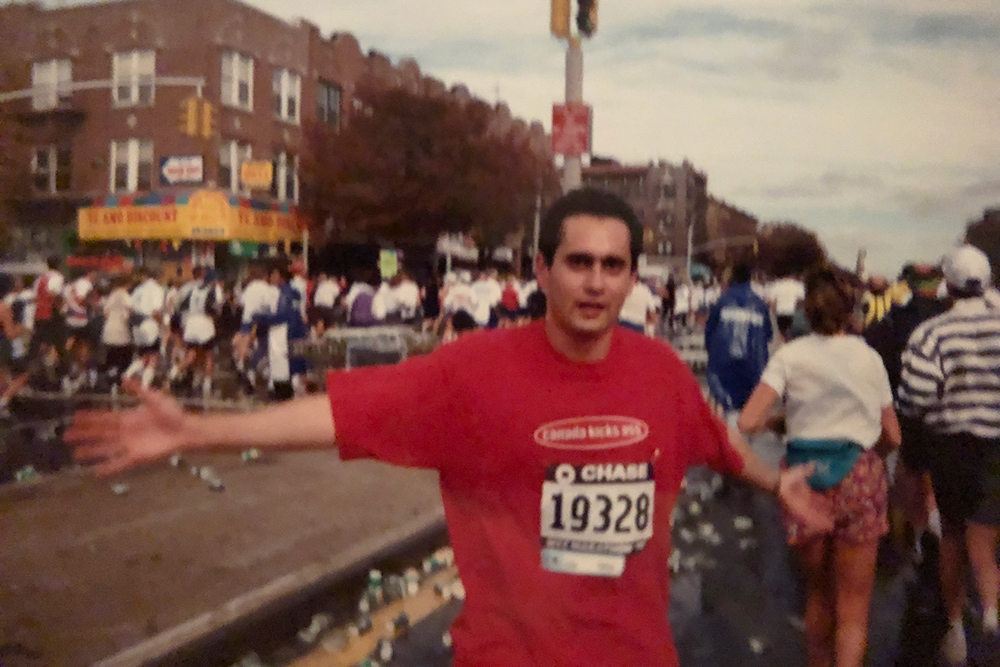
我追逐50州马拉松目标几乎纯属偶然。我的一位跑友基思•拉斯卡莱亚是纽约的一位医生,他已经追逐(并已经实现了)50州马拉松目标,他说服我和他一起参加2011年12月在特拉华州雷霍博斯海滩举办的马拉松比赛。他认为,我几周前参加了纽约市马拉松比赛,因此我仍然处于马拉松状态。我为什么没有先训练几个月再参加全马比赛呢?
次年一月,我和丈夫马尔滕去迈阿密海滩度假,正好赶上迈阿密举办马拉松比赛。我认为基思的提议不错,于是报名参加了那场比赛。不久之后,我又参加了新泽西州开普梅和罗德岛州普罗维登斯马拉松比赛,不知不觉中,我已经跑了五个州,或已实现了目标的10%。不知何故,这种做法看起来更加可行。
在生活和工作中,我在许多重大方面都是采取这种做法,如写一篇长篇文章和骑一整天自行车:我把一项大任务分解成更小、易消化的小任务。跑马拉松时,在6.55英里处,我告诉自己,“完成了四分之一”;在10英里处,我想,“不错,你已经跑了两位数。”在13.1英里处,我知道前面的路比后面的短;在16英里处,我想,“还有不到10英里。”在20英里处,我开始将余下的距离想象成在中央公园跑一圈,我已经在中央公园跑了几千次了。
跑马拉松也是到一个新的地方游玩的好方法,比如底特律、德卢斯、圣路易斯和辛辛那提,否则我可能不会去这些地方旅游。我想,“进展如何,非常轻松,”之后,我不停地参加比赛。2014年末跑完达拉斯马拉松后,我已跑完了19个州的马拉松,于是,我决定跑完50个州的马拉松。由于当时我跑完一场马拉松的时长一般在3小时32分到4小时24分之间,介于稳定成绩至马拉松公路杀手之间,我并没有强迫自己跑更快。但是,我的成绩显然不是很好,我深知我可以跑更快。
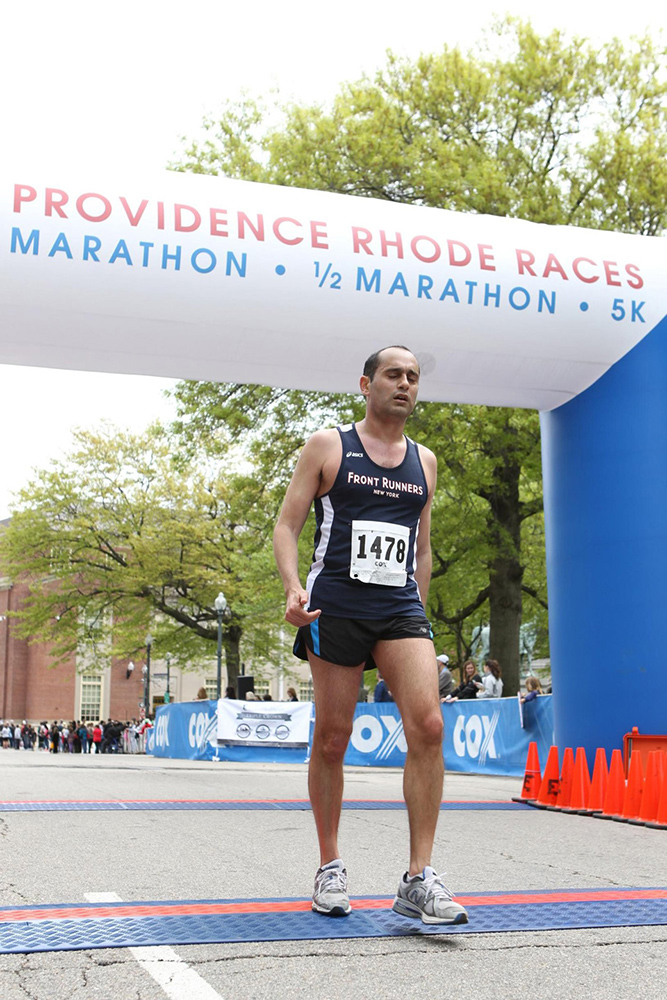
警钟
跑26.2英里听起来很简单:一步一步,几个小时就跑完了。一开始,我主要进行跑步训练,有时进行爬坡训练,再辅助做一些速度练习。在跑步训练上,我从不偷懒。但我不愿进行力量训练和伸展训练。我也不愿锻炼心脏,但锻炼心脏是让运动员在训练中改变运动强度,根据运动强度,从而使心脏有效地泵送血液和氧气。多年来,对于那些在训练期间不停地盯着其精美的GPS手表或胸前佩戴心脏监护仪的跑友,我一直不屑一顾。我认为这些人有些自恋,他们把训练和自己看得太重了。我觉得他们未能领会到跑步的禅意,过于注重心率似乎会破坏跑步的禅意。
尽管我的训练有这些不足之处,但多年来我基本上避免了受伤。我确信4小时完成马拉松(我当时的平均水平)已经足够好了,特别是因为我一年跑好几场马拉松。虽然4小时是个不错的成绩,但我仍未接近获得波士顿马拉松参赛资格的成绩,一些朋友告诉我,“你知道该怎么做。”好多次,我不得不步行走完马拉松的最后六英里,这明显说明我的跑步策略不对。
尽管如此,我每年的参赛频率仍然很高,平均每年跑六、七个州。我的目标是:50岁前跑完50个州,我将在2020年实现这个目标。一场马拉松成了下一场马拉松的训练场地,如此反复。但我很快就为此付出了代价。
2016年10月至2017年5月是我的爆发期,我跑了八场马拉松。果然,不可避免的事情终于发生了。 2017年5月,我在俄勒冈州尤金参加太平洋西北马拉松比赛,快到22英里时,困扰我好几个星期的小腿疼痛进一步恶化,我最终不得不一瘸一拐地走到终点。即使经过几天冰敷和消炎治疗,疼痛仍未能缓减,我意识到我可能不能跑步了。
回到纽约,一位体育医生告诉我马上停跑两个月。他的建议是对的,但诊断却有误。原来,这位著名的医生误读了我的X光片,他以为我的两条小腿都发生了双应力骨折。那年9月,随访检查发现,我的小腿疼痛仍未能好转,他建议我做手术,但这也可能意味着我再也不能跑马拉松了。
眼看要失去生命中最重要的解压方法,我有些恐慌,但很快,曾担任纽约市马拉松医疗顾问的一位整形外科医生给出了其他建议。他认为我得了胫骨骨膜炎(诊断正确),对于经常跑步的人,这种病虽然痛苦,但很常见,也易于治疗。
这位医生给我开了理疗处方,他敦促我要认真进行力量训练。例如,谁知道臀部肌群越强壮,小腿越省劲?或者仰卧起坐可增强核心肌群,增强支承力,膝关节承重能力更强?似乎除了我,每个人都知道。
于是,我行动起来,做理疗,进行跑步训练,同时进行交叉训练,增加骑自行车和游泳的次数,让我的骨骼得到休息,并锻炼在跑步中起到支撑作用的肌肉。我还在我的跑步俱乐部纽约领跑协会(Front Runners New York)帮助下进行速度训练,我也像我经常嘲笑的那些跑友一样,戴上了智能手表。
我的努力取得了立杆见影的效果。在被诊断为胫骨骨膜炎后的两个月,我又开始参加全程马拉松比赛。 2017年11月,我以3 小时49分的成绩跑完了在堪萨斯州奥弗兰公园(Overland Park)举办的全程马拉松比赛,这是我一年来跑得最快的一次。接下来的几周里,我跑完了西雅图和图森省马拉松比赛,用时更短。在我的目标清单中的最后15场比赛中,我平均用时3小时 40分左右。有时,我很后悔,我用了这么长时间才最终明白了其他跑友坚持的显而易见的真理。
跑了数十场马拉松之后,我终于学会了另一件事:跑太快不能建立时间缓冲。我至少在20场比赛中严重受挫。学习需要时间,但确实有效,要跑慢一点,掌握节奏,为比赛后期存储能量绝对是明智的。
2018年,我在北达科他州法戈市参加了马拉松比赛,这也是我的第41个州马拉松比赛,尽管我觉得我很强壮,但3:40组的一名领跑员告诉我,跑到16英里标记处时,才能离开她。艾比戴着长颈鹿似的耳朵,用她的便携式音箱播放尼尔•戴蒙德的歌曲,她告诉我:保持冷静,我不让你离开,你不能离开。当我们跑到16英里标记处时,我确认我感觉很好,她让我快跑,我迅速跑离了她的视线。在整场比赛中,我在最后六英里跑得最快。
在接下来的几场马拉松比赛中,我仍采用这一策略,取得了不错的成绩,最终在 12 月夏威夷马拉松比赛创造了 3小时24分 的个人记录,当年我 48 岁。我的接受新事物的速度明显很慢,但我终于学会了。 我现在是纽约市马拉松比赛的一名领跑员,并向跑友传授我的法戈马拉松比赛领跑员传授给我的来之不易的智慧。

营养问题也让我花了很长时间才弄明白。在20世纪90年代,传统智慧是在比赛前几天像恶魔一样大量摄入碳水化合物,并在比赛当天早上大量饮水,以免在马拉松比赛期间耗尽体力或脱水。但在比赛前几天里,包括比赛前夜,我经常会吃很多意大利面,吃得过饱,我的消化系统不堪重负。我最终发现,胃肠道不适对马拉松比赛不利。
现在,我在马拉松比赛前一天吃得比平时多一点,但在比赛当天早上我只吃一个花生酱百吉圈和一根香蕉,我再也不会吃得过饱了。我过去常常在比赛当天早上和比赛期间喝很多水,以至于我的钠含量极低,极其危险。在多场马拉松比赛中,我都会在比赛期间或之后呕吐;事实上,如果我不呕吐,朋友们反而会感到惊讶。
旅行欲望和隐藏的珍宝
如果我的目标只是尽快跑完一场比赛,我就不会一年跑六、七场马拉松。我会选择不同的马拉松。我跑过的两条最美丽的赛道是加利福尼亚州大苏尔(Big Sur)和缅因州阿卡迪亚国家公园(Acadia National Park)的芒特迪瑟特岛(Mount Desert Island),这里多山,也是我跑得最慢的赛道之一。
事实上,对我来说,像最终破解马拉松密码一样,能够满足我的旅行欲望的景色也是我跑马拉松的一大动力。美国到处都是隐藏的珍宝,探索这些珍宝充满乐趣。比如:2017年,在南达科他州扬克顿马拉松比赛途中,我在弗米利恩(Vermillion)大学城停下来,喝了杯咖啡。我发现国家音乐博物馆就在此地,国家音乐博物馆是世界上最著名的乐器博物馆之一,收藏了15,000件乐器,其中包括17世纪的中提琴和1890年的马丁吉他等珍品。
参加法戈马拉松比赛时,我参观了附近明尼苏达州穆尔黑德的维京海盗船博物馆(Viking ship museum)。路易斯维尔的肯塔基德比马拉松赛道穿过丘吉尔•唐斯赛马场(Churchill Downs racecourse)。绿湾马拉松赛道穿过标志性的蓝堡球场,这里是美国职业橄榄球联盟包装工队的主场。还有一些比赛有着奇怪的传统:在Go St-Louis马拉松比赛中,一名牧师会在8英里处向跑者洒圣水,而在大苏尔比赛中,一名男子在比赛前半程结束处的太平洋海岸公路上弹钢琴。
不可思议的是,我只取消了一场马拉松比赛(2013年达拉斯比赛,因冰暴被迫取消)。旅行可能会很累,但到一个新地方,寻找最好的意式餐厅,或者享用赛事主办方提供的意大利面晚餐,或者只是找个地方吃煎饼,补充碳水化合物,都很有趣。(尤其向往怀俄明州卡斯珀的Eggington’s!)尽管每场比赛各有特色,但无论是有52,000 名完赛者的纽约马拉松比赛还是有 41 名完赛者的扬克顿 River Rat马拉松比赛,每场比赛都有一种部落感。
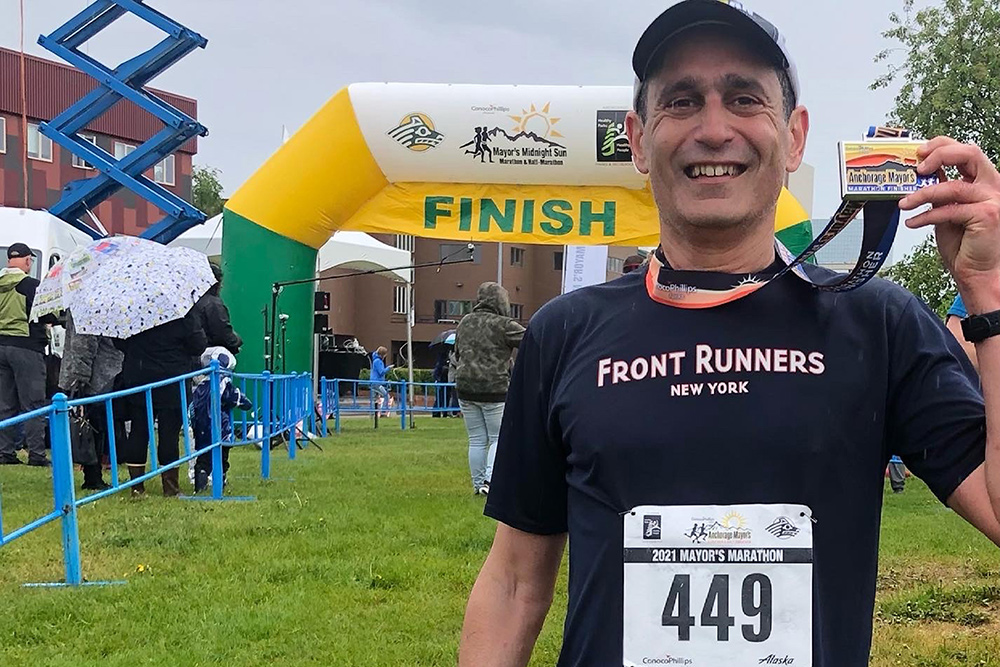
无论人数多少,大家聚在一起就会充满乐趣。每场比赛都会发生一些有趣的事情:一些观众会用音响大声播放歌曲《Eye of the Tiger》或《Chariots of Fire》,他们确信自己是第一个想到这样做的人。在18英里处(我也想尖叫,但精力有限),总有一些善意但有点烦人的人大喊“你就快到了”或者“快跑,福勒斯特快跑”。 还有一些人会开玩笑地打出标语“谁需要脚趾甲?” 或者“我和马拉松运动员约会是因为他们能坚持很长时间。”
现在,我完成了我的目标,很多人都问,你下一步想做什么?再来一遍?(不)跑完加拿大的10个省份?可能。(我完成了10%)参加铁人三项?很可能在2022年参加,因为我现在也对铁人三项有点着迷。
但我的马拉松参赛目标还未全部实现:尽管我后来的成绩不错,但波士顿马拉松仍在嘲笑我。本周,我通过一场援助纽约路跑协会儿童组的慈善活动参加了波士顿马拉松比赛。但我深知,以我的马拉松成绩,我仍然无法获得波士顿马拉松参赛资格,但是只有获得波士顿参赛资格,我才会真正感到满足。以我的年龄,我应该能取得比3小时25分更好的成绩。这就是我的下一个目标。当然,我已经从50州马拉松比赛中积累了丰富的经验。(财富中文网)
译者:李亚男
审校:汪皓
这个标题提出的问题非常具有阿拉斯加特色。今年6月,在安克雷奇市长马拉松比赛进行到一半时,我正在一条绿树成荫的碎石小道上跑着,另一位跑者指给我看,我那时并不害怕。我抓紧时间跑步,我只想安全地完成比赛,最终实现跑完美国各州(以及额外增加的华盛顿特区)全马公路赛的目标。
多年来,我在参加马拉松比赛时遭遇了各种挑战和不幸:由于训练不足,我经常会感到不适;在离终点线不远处呕吐,我在罗德岛州和弗吉尼亚参加比赛时就出现了这种情况(每次比赛用时不到四个小时,但就在最后不到一分钟功亏一篑!),因为我的碳水化合物补充策略不当;由于虚脱被抬入医疗帐篷(两次!分别在威斯康星州和爱荷华州);乳头擦伤(只需一次就会得到教训)等等。但要是遇到熊?那就太糟了。
在阿拉斯加比赛中,我很幸运。我刚刚从那只熊和她的两个幼崽休息的地方跑过。熊的出现迫使比赛总监不得不临时为我身后的数百名选手重新安排了比赛路线,但我仍沿着原定路线跑。
比赛顺利结束。(当我发现只有我一人出现在树木茂密的赛段时,我唱起了“Fozzie Bear stay away, Fozzie Bear stay away”,我感觉不那么害怕了。)最终,我越过了设在市中心安克雷奇公园的第51条终点线。共有389名选手完成了此次马拉松比赛,我是其中之一,还包括当日和我一起加入50州完赛俱乐部的少数人。
比赛期间,倾盆大雨,人群稀少,所以没有多少欢呼声。尽管这是我长达十年追求到达的巅峰,但那一刻对我来说有点平淡,这也说明这并不是什么大不了的事。我至少赢得了奖牌发放者的喝彩。我向她喊道,“我刚刚完成了我的50个州马拉松比赛目标!”她听到后,热情地与我击掌祝贺,但仍与我保持社交距离,我们只有指尖碰在一起。
奔跑十年精彩瞬间(从左上角开始顺时针方向):作者分别在北卡罗来纳州法戈;西雅图;夏威夷州希洛;新墨西哥州希普克;孟菲斯;密苏拉;南达科他州米切尔;及加利福尼亚州大苏尔。
就这样,多年来主宰我生活的挑战最终完结,在参加马拉松比赛期间,我游览过很多美丽壮观的地方,如北卡罗来纳州阿什维尔的比尔特莫尔庄园、加利福尼亚州大苏尔的悬崖,以及位于阿拉巴马州亨茨维尔的美国太空火箭中心等。
在实现这个目标时,我加入了一个马拉松运动员小团体:50州马拉松俱乐部(50 States Marathon Club)。是的,我们有一个俱乐部——由一群业余跑者志愿组成的团体,为完赛者提供认证,并决定在哪个州举办马拉松比赛。俱乐部要求提供完成的每场比赛的证明,已为1,821人认证。(还有很多人也完成了比赛,但尚未经俱乐部官方认可。)最终会有更多的铁杆马拉松运动员加入这一队伍:俱乐部拥有近 5,000 名会员,并且仍在不断发展壮大。
目前,马拉松比赛的整体情况并非如此。根据贸易组织Running USA的数据,2019年,美国马拉松参赛人次从2014年的峰值55.1万降到42.7万。(由于2020年大多数比赛被取消,因此无2020年数据)。可供选择的比赛也越来越少——现在仍有约 1,000 场美国马拉松比赛,低于 2015 年1,200 场的历史最高水平。几十年风靡之后,马拉松渐渐失去了一些人气,因为跑者喜欢半程马拉松等短距离比赛以及铁人三项、最强泥人(Tough Mudder)和主车团(Peloton)等替代项目。
50州马拉松俱乐部的会员包括大量退伍军人和航空公司工作人员,他们可以享受机票和酒店折扣价格,旅行更加实惠。俱乐部往往会吸引多产马拉松运动员,而不是超快马拉松运动员。(跑完全程马拉松需要三小时以下的人一般不会参加那么多比赛。)
尽管追逐目标很有趣,但我很快发现,跑步和生活一样,无论你取得的成就多么令人印象深刻,总会有人超越你。一名50州俱乐部会员已经七次完成了这项壮举。还有一组跑者也跑完了50州马拉松,且每场马拉松用时均不到四个小时。(我必须重新参加18场马拉松才能获得资格。)此外,还有一个高级俱乐部,会员全部是至少完成300场马拉松的跑者。
“这是一种承诺,一种爱,有时简直会让人觉得精神失常,”俱乐部主席洛伊斯•伯科维茨说,她已经五次跑完50州马拉松,最近一次比赛是2019年底在华盛顿贝灵厄姆。“我想说,我们很多会员都有些不正常,”这位前人力资源专家开玩笑说。
我完全同意。当人们问我这些年来我为什么坚持跑马拉松时,我会开玩笑地说:“因为这50个州就在那。”但说真的,我这样做有多种原因。首先,我只是喜欢马拉松的长距离,我共参加了71场马拉松比赛。其次,我喜欢旅行。但还有一些其他因素:我是一名相当不错的跑者,只是不是一名出色的跑者。在这71场比赛中,没有一场比赛的速度足以让我获得参加波士顿马拉松比赛(美国最负盛名的比赛)的资格。我重量不重质。尽管如此,随着我参加的马拉松越来越多,并在2017年终于战胜了困扰我的伤病,我终于意识到,只要训练更加严格、更加科学,我可以跑得更快,比赛对我这个中年人的身体带来的伤害也会越小,这个发现本身就是一大回报,是我要追求的更高成就中的另一个目标。
纯属偶然
和人类的每一项活动一样,长跑也有自己的文化和亚文化。一些跑者把参加马拉松视为一项遗愿清单,是一劳永逸的努力。一些跑者则是速度狂人,他们唯一的目标是获得像波士顿马拉松比赛这样的精英赛事的参赛资格,有些人则是自豪的背包客,乐于在六小时以上跑完一场马拉松。还有一些人主要是为了收集奖牌,奖牌越大越俗气越好。还有一些50州马拉松跑者,喜欢将“耐力运动”中的“耐力”理念发挥到极致。
1997年,我搬到纽约,一年后,我开始跑步,主要为了缓减这座城市给我带来的压力。我发现长跑可以让我进入一种冥想状态,比短跑、快跑更吸引人,因此,我选择跑马拉松。
作者参加1998年纽约市马拉松比赛,这是他首次参加马拉松比赛,也是最后一次穿棉质T恤跑步。(棉质衣服容易擦伤皮肤。)图片由作者提供。
我追逐50州马拉松目标几乎纯属偶然。我的一位跑友基思•拉斯卡莱亚是纽约的一位医生,他已经追逐(并已经实现了)50州马拉松目标,他说服我和他一起参加2011年12月在特拉华州雷霍博斯海滩举办的马拉松比赛。他认为,我几周前参加了纽约市马拉松比赛,因此我仍然处于马拉松状态。我为什么没有先训练几个月再参加全马比赛呢?
次年一月,我和丈夫马尔滕去迈阿密海滩度假,正好赶上迈阿密举办马拉松比赛。我认为基思的提议不错,于是报名参加了那场比赛。不久之后,我又参加了新泽西州开普梅和罗德岛州普罗维登斯马拉松比赛,不知不觉中,我已经跑了五个州,或已实现了目标的10%。不知何故,这种做法看起来更加可行。
在生活和工作中,我在许多重大方面都是采取这种做法,如写一篇长篇文章和骑一整天自行车:我把一项大任务分解成更小、易消化的小任务。跑马拉松时,在6.55英里处,我告诉自己,“完成了四分之一”;在10英里处,我想,“不错,你已经跑了两位数。”在13.1英里处,我知道前面的路比后面的短;在16英里处,我想,“还有不到10英里。”在20英里处,我开始将余下的距离想象成在中央公园跑一圈,我已经在中央公园跑了几千次了。
跑马拉松也是到一个新的地方游玩的好方法,比如底特律、德卢斯、圣路易斯和辛辛那提,否则我可能不会去这些地方旅游。我想,“进展如何,非常轻松,”之后,我不停地参加比赛。2014年末跑完达拉斯马拉松后,我已跑完了19个州的马拉松,于是,我决定跑完50个州的马拉松。由于当时我跑完一场马拉松的时长一般在3小时32分到4小时24分之间,介于稳定成绩至马拉松公路杀手之间,我并没有强迫自己跑更快。但是,我的成绩显然不是很好,我深知我可以跑更快。
警钟
跑26.2英里听起来很简单:一步一步,几个小时就跑完了。一开始,我主要进行跑步训练,有时进行爬坡训练,再辅助做一些速度练习。在跑步训练上,我从不偷懒。但我不愿进行力量训练和伸展训练。我也不愿锻炼心脏,但锻炼心脏是让运动员在训练中改变运动强度,根据运动强度,从而使心脏有效地泵送血液和氧气。多年来,对于那些在训练期间不停地盯着其精美的GPS手表或胸前佩戴心脏监护仪的跑友,我一直不屑一顾。我认为这些人有些自恋,他们把训练和自己看得太重了。我觉得他们未能领会到跑步的禅意,过于注重心率似乎会破坏跑步的禅意。
尽管我的训练有这些不足之处,但多年来我基本上避免了受伤。我确信4小时完成马拉松(我当时的平均水平)已经足够好了,特别是因为我一年跑好几场马拉松。虽然4小时是个不错的成绩,但我仍未接近获得波士顿马拉松参赛资格的成绩,一些朋友告诉我,“你知道该怎么做。”好多次,我不得不步行走完马拉松的最后六英里,这明显说明我的跑步策略不对。
尽管如此,我每年的参赛频率仍然很高,平均每年跑六、七个州。我的目标是:50岁前跑完50个州,我将在2020年实现这个目标。一场马拉松成了下一场马拉松的训练场地,如此反复。但我很快就为此付出了代价。
2016年10月至2017年5月是我的爆发期,我跑了八场马拉松。果然,不可避免的事情终于发生了。 2017年5月,我在俄勒冈州尤金参加太平洋西北马拉松比赛,快到22英里时,困扰我好几个星期的小腿疼痛进一步恶化,我最终不得不一瘸一拐地走到终点。即使经过几天冰敷和消炎治疗,疼痛仍未能缓减,我意识到我可能不能跑步了。
回到纽约,一位体育医生告诉我马上停跑两个月。他的建议是对的,但诊断却有误。原来,这位著名的医生误读了我的X光片,他以为我的两条小腿都发生了双应力骨折。那年9月,随访检查发现,我的小腿疼痛仍未能好转,他建议我做手术,但这也可能意味着我再也不能跑马拉松了。
眼看要失去生命中最重要的解压方法,我有些恐慌,但很快,曾担任纽约市马拉松医疗顾问的一位整形外科医生给出了其他建议。他认为我得了胫骨骨膜炎(诊断正确),对于经常跑步的人,这种病虽然痛苦,但很常见,也易于治疗。
这位医生给我开了理疗处方,他敦促我要认真进行力量训练。例如,谁知道臀部肌群越强壮,小腿越省劲?或者仰卧起坐可增强核心肌群,增强支承力,膝关节承重能力更强?似乎除了我,每个人都知道。
于是,我行动起来,做理疗,进行跑步训练,同时进行交叉训练,增加骑自行车和游泳的次数,让我的骨骼得到休息,并锻炼在跑步中起到支撑作用的肌肉。我还在我的跑步俱乐部纽约领跑协会(Front Runners New York)帮助下进行速度训练,我也像我经常嘲笑的那些跑友一样,戴上了智能手表。
我的努力取得了立杆见影的效果。在被诊断为胫骨骨膜炎后的两个月,我又开始参加全程马拉松比赛。 2017年11月,我以3 小时49分的成绩跑完了在堪萨斯州奥弗兰公园(Overland Park)举办的全程马拉松比赛,这是我一年来跑得最快的一次。接下来的几周里,我跑完了西雅图和图森省马拉松比赛,用时更短。在我的目标清单中的最后15场比赛中,我平均用时3小时 40分左右。有时,我很后悔,我用了这么长时间才最终明白了其他跑友坚持的显而易见的真理。
跑了数十场马拉松之后,我终于学会了另一件事:跑太快不能建立时间缓冲。我至少在20场比赛中严重受挫。学习需要时间,但确实有效,要跑慢一点,掌握节奏,为比赛后期存储能量绝对是明智的。
2018年,我在北达科他州法戈市参加了马拉松比赛,这也是我的第41个州马拉松比赛,尽管我觉得我很强壮,但3:40组的一名领跑员告诉我,跑到16英里标记处时,才能离开她。艾比戴着长颈鹿似的耳朵,用她的便携式音箱播放尼尔•戴蒙德的歌曲,她告诉我:保持冷静,我不让你离开,你不能离开。当我们跑到16英里标记处时,我确认我感觉很好,她让我快跑,我迅速跑离了她的视线。在整场比赛中,我在最后六英里跑得最快。
在接下来的几场马拉松比赛中,我仍采用这一策略,取得了不错的成绩,最终在 12 月夏威夷马拉松比赛创造了 3小时24分 的个人记录,当年我 48 岁。我的接受新事物的速度明显很慢,但我终于学会了。 我现在是纽约市马拉松比赛的一名领跑员,并向跑友传授我的法戈马拉松比赛领跑员传授给我的来之不易的智慧。
营养问题也让我花了很长时间才弄明白。在20世纪90年代,传统智慧是在比赛前几天像恶魔一样大量摄入碳水化合物,并在比赛当天早上大量饮水,以免在马拉松比赛期间耗尽体力或脱水。但在比赛前几天里,包括比赛前夜,我经常会吃很多意大利面,吃得过饱,我的消化系统不堪重负。我最终发现,胃肠道不适对马拉松比赛不利。
现在,我在马拉松比赛前一天吃得比平时多一点,但在比赛当天早上我只吃一个花生酱百吉圈和一根香蕉,我再也不会吃得过饱了。我过去常常在比赛当天早上和比赛期间喝很多水,以至于我的钠含量极低,极其危险。在多场马拉松比赛中,我都会在比赛期间或之后呕吐;事实上,如果我不呕吐,朋友们反而会感到惊讶。
旅行欲望和隐藏的珍宝
如果我的目标只是尽快跑完一场比赛,我就不会一年跑六、七场马拉松。我会选择不同的马拉松。我跑过的两条最美丽的赛道是加利福尼亚州大苏尔(Big Sur)和缅因州阿卡迪亚国家公园(Acadia National Park)的芒特迪瑟特岛(Mount Desert Island),这里多山,也是我跑得最慢的赛道之一。
事实上,对我来说,像最终破解马拉松密码一样,能够满足我的旅行欲望的景色也是我跑马拉松的一大动力。美国到处都是隐藏的珍宝,探索这些珍宝充满乐趣。比如:2017年,在南达科他州扬克顿马拉松比赛途中,我在弗米利恩(Vermillion)大学城停下来,喝了杯咖啡。我发现国家音乐博物馆就在此地,国家音乐博物馆是世界上最著名的乐器博物馆之一,收藏了15,000件乐器,其中包括17世纪的中提琴和1890年的马丁吉他等珍品。
参加法戈马拉松比赛时,我参观了附近明尼苏达州穆尔黑德的维京海盗船博物馆(Viking ship museum)。路易斯维尔的肯塔基德比马拉松赛道穿过丘吉尔•唐斯赛马场(Churchill Downs racecourse)。绿湾马拉松赛道穿过标志性的蓝堡球场,这里是美国职业橄榄球联盟包装工队的主场。还有一些比赛有着奇怪的传统:在Go St-Louis马拉松比赛中,一名牧师会在8英里处向跑者洒圣水,而在大苏尔比赛中,一名男子在比赛前半程结束处的太平洋海岸公路上弹钢琴。
不可思议的是,我只取消了一场马拉松比赛(2013年达拉斯比赛,因冰暴被迫取消)。旅行可能会很累,但到一个新地方,寻找最好的意式餐厅,或者享用赛事主办方提供的意大利面晚餐,或者只是找个地方吃煎饼,补充碳水化合物,都很有趣。(尤其向往怀俄明州卡斯珀的Eggington’s!)尽管每场比赛各有特色,但无论是有52,000 名完赛者的纽约马拉松比赛还是有 41 名完赛者的扬克顿 River Rat马拉松比赛,每场比赛都有一种部落感。
无论人数多少,大家聚在一起就会充满乐趣。每场比赛都会发生一些有趣的事情:一些观众会用音响大声播放歌曲《Eye of the Tiger》或《Chariots of Fire》,他们确信自己是第一个想到这样做的人。在18英里处(我也想尖叫,但精力有限),总有一些善意但有点烦人的人大喊“你就快到了”或者“快跑,福勒斯特快跑”。 还有一些人会开玩笑地打出标语“谁需要脚趾甲?” 或者“我和马拉松运动员约会是因为他们能坚持很长时间。”
现在,我完成了我的目标,很多人都问,你下一步想做什么?再来一遍?(不)跑完加拿大的10个省份?可能。(我完成了10%)参加铁人三项?很可能在2022年参加,因为我现在也对铁人三项有点着迷。
但我的马拉松参赛目标还未全部实现:尽管我后来的成绩不错,但波士顿马拉松仍在嘲笑我。本周,我通过一场援助纽约路跑协会儿童组的慈善活动参加了波士顿马拉松比赛。但我深知,以我的马拉松成绩,我仍然无法获得波士顿马拉松参赛资格,但是只有获得波士顿参赛资格,我才会真正感到满足。以我的年龄,我应该能取得比3小时25分更好的成绩。这就是我的下一个目标。当然,我已经从50州马拉松比赛中积累了丰富的经验。(财富中文网)
译者:李亚男
审校:汪皓
This is a very Alaska question to be asked. And since it was being posed to me by a fellow runner as I ran along a tree-lined gravel trail, halfway through the Anchorage Mayor’s Marathon this June, it was not one I was thrilled to hear. I was making good time, and I just wanted to safely complete the course—and finish, at long last, my quest to run a 26.2-mile road race in every U.S. state (along with Washington, D.C., for good measure).
Over the years, I’ve faced all manner of challenges and mishaps during marathons: hitting the wall (often) due to inadequate training; throwing up mere yards from the finish line, as I did in Rhode Island and Virginia (costing me sub-four-hour finishes each time—by less than a minute!) because of faulty carbo-loading and hydration; landing in the medical tent (twice! In Wisconsin and Iowa) from heat exhaustion; suffering chafed nipples (a lesson you only need learn once) and so on. But a bear encounter? That would have been an unwelcome first.
In Alaska, I got lucky. It turns out I had just run past the spot that the ursine miscreant and her two cubs had chosen for a short break. Their appearance caused the race director to temporarily re-route the race for the hundreds of runners behind me, but I ran on unhindered.
The race ended without incident. (It undoubtedly helped that I sang “Fozzie Bear stay away, Fozzie Bear stay away,” when I found myself alone in wooded sections of the course.) And I eventually crossed that 51st finish line in a downtown Anchorage park. I was one of 389 runners to complete the marathon, including a handful who joined the club of 50-state finishers with me that day.
It was pouring rain, and the crowds were thin, so there wasn’t much cheering. The moment felt a bit anti-climactic to me, suggesting that this wasn’t such a big deal even though it was the culmination of a decade-long pursuit. I did at least win some praise from the race employee handing out the medals: After I shouted to her, “I just finished my 50 states!”, she gave me an energetic, socially distanced high-five that saw only the tips of our fingertips touch.
Thus ended a challenge that has dominated my life for years and seen me run marathons in such wonderful locales as the Biltmore estate in Asheville, N.C., the cliffs of Big Sur, Calif., and a park for retired NASA rockets in Huntsville, Alabama.
In reaching this goal, I joined a tiny subset of marathoners: the 50 States Marathon Club. And yes, there is an actual club—a volunteer, amateur group of runners pursuing this goal that provides certification to finishers, along with ideas about which marathons to choose in what state. The club requires proof of each race finished, and it knows of 1,821 people who have completed the challenge. (An unknown number more have done it, too, without the club’s official recognition.) More hard-core marathoners will eventually join the cohort: The club has almost 5,000 members and is going strong.
The same can’t be said right now for marathons overall. Marathon participation in the U.S. fell to 427,000 finishes in 2019 from its 2014 peak of 551,000, according to the trade organization Running USA. (No data were compiled for 2020 because most races were cancelled.) There are also fewer races from which to choose—some 1,000 U.S. marathons still exist now, down from an all-time high of 1,200 in 2015. After a multi-decade boom, marathons have lost some popularity, as runners favor smaller distances like the half marathon as well as alternatives such as triathlons, activities like Tough Mudder, and Peloton.
The 50 States Marathon Club’s membership ranks include a disproportionate number of people such as military veterans and airline workers, who get discounted airline and hotel prices, making all the travel more affordable. And it tends to attract prolific marathoners rather than super-fast ones. (People who can run a sub-three-hour marathon don’t tend to run that many of them.)
As fun as it was to chase this goal, I quickly learned that in running as in life, no matter how impressive your achievement, there is always someone who has outdone you. One 50 States club member member has completed the feat seven times. There is a separate group of runners who have done all 50 states in better than four hours. (I would have to redo 18 of my races under that time to qualify.) And there is an exclusive club out there for runners who have completed at least 300 marathons.
“There is a commitment to it, it's a love, and sometimes it's literally insanity,” says Lois Berkowitz, who is president of the club and has completed the 50 states five times, completing her latest tour in late 2019, in Bellingham, Washington. “A lot of our members, I would say, are a little left of normal,” the former HR specialist jokes.
No argument from me. When people ask me what motivated me over all those years, I like to quip, “Because the states were there.” But in all seriousness, the desire to do this came from a variety of sources. For one thing, I simply love the marathon distance, and have run 71 in all. And I love traveling. But there was something else at play: the humbling fact that I am a quite good runner, just not a great one. Not one of those 71 marathons was fast enough to qualify me for the Boston Marathon, the most prestigious of America’s races. There was an element of trading quality for quantity in my quest. Still, as I knocked off more and more states, and overcame a worrisome injury in 2017, I finally started to see I could get faster and make the races less punishing on my middle-aged body if I took a more rigorous, almost scientific approach to my training—and that discovery was rewarding on its own, another goal to chase within the larger achievement
A quest begins, almost accidentally
Like every human activity, long-distance running has its own culture and subcultures. Some runners see marathons as a bucket-list, one-and-done endeavor. Others are speed demons whose sole goal is to qualify for an elite race like Boston, while others yet are proud back-of-the-packers happy to run one in six hours plus. There is also a cohort whose big motivation comes from collecting medals—the bigger and tackier, the better. And there are people like the 50-staters who take the idea of “endurance” in “endurance sport” to the extreme.
I started running a year after moving to New York in 1997 to combat the city’s stress. I found the meditative state I could reach on longer runs more appealing than the rush of a short, fast race, and so the marathon became my race of choice.
My 50-state quest started almost accidentally. A runner friend of mine, Keith LaScalea, a New York physician who was already pursuing (and has achieved) the 50-state goal, convinced me to join him for a race in Rehoboth Beach, Delaware, in December 2011. He reasoned that I was still in marathon shape from having run the New York City marathon a few weeks earlier. So why not literally get more mileage out of my months of training and do another 26.2-mile race?
The following January, my husband Maarten and I were going to Miami Beach for a short holiday that coincided with that city’s marathon. I used the same reasoning that Keith had suggested, and signed up for that race, too. Marathons in Cape May, New Jersey and Providence, R.I. soon followed, and before you know it, I had run five states, or 10% of the total. That somehow made the endeavor start to seem more feasible.
I take a similar approach to many big endeavors in life and work, including writing a long magazine piece and doing a day-long bike ride: I break down the large task into smaller, digestible pieces. When running a marathon, at mile 6.55 I tell myself, “One quarter of the way done”; at mile 10, I think, “ok, you’ve done double digits.” At mile 13.1, I know there is less road in front of me than in back; at mile 16, I think, “less than 10 to go.” And at mile 20, I start to visualize the remaining distance as one loop of Central Park, which I’ve run thousands of times.
My marathon-hopping was also proving to be a fun way to see new places, like Detroit, Duluth, St. Louis, and Cincinnati, that I would likely not have bothered visiting otherwise. I thought, “Let’s see where this goes, no pressure,” and I continued. But once I reached 19 states, with my Dallas marathon in late 2014, I decided to go for the whole 50. I did not hold myself to hitting fast times, given that my marathons had been all over the place at that point, from 3:32 to 4:24—a range that spanned from solid result to being marathon roadkill. Yet I was clearly underachieving, and I knew deep down I could get much faster.
A wake-up call
Running 26.2 miles sounds simple enough: Just put one foot in front of the next and continue for a few hours. Early on, my focus during training was simply doing the mileage, with some hill repeats and a bit of speed work to supplement it. I never skimped on distance. But I was lazy about things like strength work and stretching. I also avoided training by heart zone, which involves teaching the heart to be efficient in pumping blood, and therefore oxygen, according to effort levels, by having the athlete vary the intensity of effort within a workout. For years I rolled my eyes at fellow runners who were constantly looking at their fancy GPS watches during training or wearing heart monitors across their chests. I saw such behavior as self-absorbed, a sign that they took their training and themselves too seriously. I felt they were missing out on the Zen aspect of running, which obsessing about one’s heart rate seemed to undermine.
Despite those inadequacies in my training, I somehow largely avoided injuries for many years. I had convinced myself that 4:00 marathons, my average at that point, were good enough, especially since I was running several a year. But while four hours is a good time, I wasn’t even coming close to qualifying for Boston, and some friends were telling me, “You know what to do.” In addition, the number of times I had to walk for much of the final six miles of a marathon made it crystal clear I was not doing it quite right.
Still, I was knocking states off my list at a good clip, averaging six or seven states a year. My catchy goal: finishing the 50 states by age 50, which I would hit in 2020. One marathon became a long training run for the next one, and so on. I would soon pay a price for that.
In a particularly intense burst between October 2016 and May 2017, I ran eight marathons. Sure enough, the inevitable happened. As I neared mile 22 of the Pacific Northwest marathon in Eugene, Oregon, in May 2017, the pain in my shins, which had been nagging me for weeks, grew excruciating, to the point that I limped through to the finish. Even after a few days of icing and anti-inflammatories, running seemed to have become impossible.
When I got home to New York, I was told by a sports doctor to stop running immediately for two months. That was correct advice, but it was based on a misunderstanding. It turned out this prominent physician had misread my x-rays, which showed what he thought were twin stress fractures in each tibia. That September, during a follow-up visit that showed no change in my shins, he invoked the possibility of me needing surgery that would likely end my marathon days.
Panicked and worried about the loss of the most important outlet in my life, I quickly got a second opinion from an orthopedic surgeon, the former medical director of the New York City Marathon. He diagnosed my injury—correctly—as shin splints, a painful but common and manageable injury for runners.
This second doctor prescribed physical therapy, and he urged me to start taking strength work more seriously. Who knew that the stronger one’s glutes, for instance, the less work falls on the shins way down below? Or that sit-ups mean more support from your core and an easier load for your knees? Everyone but me, it seems.
So I got to work, began PT and started rebuilding my mileage, all while cross training with more biking and swimming to give my bones a break and build up muscles that played a supporting role in running. I also got very diligent about speed work and drills with my running club, Front Runners New York, and became one of those runners I used to mock for being so tethered to their smart watches.
The benefit to my performances was immediate. Only two months after my shin-splint diagnosis, I was running full marathons again. I clocked a 3:49 time in Overland Park, Kansas in November 2017, my fastest in over a year at that point. And I shaved off even more time in Seattle and Tucson in the following weeks. In the final 15 races of my quest, my average time fell to around 3:40. Sometimes I could kick myself for how long it took me to finally get what was obvious to other runners.
Another thing I finally, finally learned after running dozens of marathons: you cannot build a time cushion when you go out too fast. I had epic flameouts in at least 20 of my races. It took time, but it did sink in that it is infinitely smarter to store energy for later in the race by going out more slowly and learning discipline in one’s pacing.
In Fargo, North Dakota, which I ran in 2018 as my 41st state, a pacer for the 3:40 group forbade me from leaving her side until mile 16, even though I insisted I felt strong. Abby, decked out in giraffe ears and blasting Neil Diamond on her portable speakers, was direct: Cool your jets, she said, until I give you the green light. When we got to that point in the race, and I confirmed I still felt great, she told me to go, get out of her sight. The last six miles were my fastest of the race.
I repeated that strategy in my next few marathons to great results, culminating with a personal record of 3:24 in Hawaii that December, at the age of 48. I am slow on the uptake apparently, but I did finally learn. I am now a pacer at the New York City marathon and impart the same hard-won wisdom to runners that my Fargo pacer did to me.
Nutrition also took me ages to nail. In the 1990s, the conventional wisdom was to carbo-load like a demon in the few days before the race and drink a ton the morning before the race, lest you run out of gas or get dehydrated during the marathon. But I often would overeat and gorge on pasta for several days before the race, including the eve, overwhelming my digestive system. GI distress is not conducive to good marathons, I can confirm.
Now, I eat a bit more than usual the day before a marathon, but have only a bagel with peanut butter and bananas the morning of, and I never bonk anymore. I used to drink so much water the morning of and during my races that my sodium got perilously low. It got to the point where I would throw up during or after the race at most of my marathons; indeed, friends were surprised if I didn’t.
Wanderlust and hidden gems
If my goal had simply been to run a race as fast as I could, I would not have run six or seven marathons a year. And I would have chosen different marathons. The two most beautiful courses I ran, Big Sur and Mount Desert Island, Maine, home of Acadia National Park, were also the hilliest—so among my slowest.
Indeed, the prospect of satisfying my wanderlust was as big a motivation for me as finally cracking the marathon code. This country is full of hidden gems, and exploring it was a big part of the fun. Case in point: En route to my Yankton, South Dakota marathon in 2017, I stopped in the small college town of Vermillion for a coffee. I discovered the place was home to the National Music Museum, one of the best-regarded music instrument museums in the world, with a collection of 15,000 instruments that includes gems like 17th century violas and a Martin guitar from 1890.
In Fargo, my marathon took me through the grounds of a Viking ship museum in neighboring Moorhead, Minn. The Kentucky Derby marathon in Louisville steered runners through the Churchill Downs racecourse. The Green Bay marathon course goes through the iconic Lambeau Field, home to the NFL’s Packers. And some races have oddball traditions: Go St-Louis has a priest at Mile 8 to cast holy water at runners, while Big Sur has a man playing a grand piano on the Pacific Coast Highway at the halfway point.
Miraculously, I only had one marathon cancellation to contend with (due to an ice storm in Dallas in 2013). The travel could be exhausting, but it’s fun to get to a new town and look for the best Italian place, or go to the pasta party if the race organizer puts one on, or look for a place for pancakes for my carbo-loading rituals. (Special shout out to Eggington’s in Casper, Wyoming!) Even though each race was different, there was a sense of tribe at each one, whether running the 52,000-finisher New York race or the 41-finisher River Rat race in Yankton.
And the crowds, whatever the size, are a big part of the fun. There are some amusing things one finds at every race: Some spectators will inevitably blast "Eye of the Tiger" or the Chariots of Fire theme from their speakers, convinced they are the first ones to have ever thought of that. There are also always the well-intentioned but slightly annoying people shouting, “You are almost there” at mile 18 (I could scream but rarely have the energy to) or “Run, Forrest run.” And there are the jokesters with signs like “Who needs toenails?” or “I date marathoners because they last a long time.”
Now that I’m done, many have asked, what do you want to do next? Do it over? (No.) The 10 provinces in my native Canada? Possibly. (I am 10% done!) An Ironman? Quite possibly in 2022, since I’ve also caught the triathlon bug now.
But I have some unfinished business with marathons: For all my later-in-life improvement, Boston is taunting me. I am running that marathon this week via a charity entry, supporting New York Road Runners’ Team for Kids. But deep down, I know I won’t be truly satisfied until I have qualified for Boston based on my racing time. At my age, that means better than 3:25. So that’s my next goal. And I certainly have enough lessons from my 50-state quest upon which to draw to get there.













